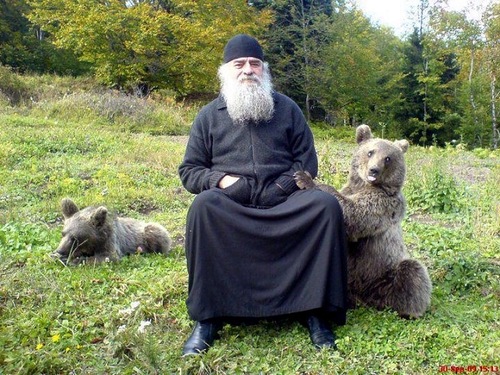After the First World War, pastors in the Roman Catholic and Protestant world began to sport a clean-cut, more modern look: beardless with cropped hair. However, many Orthodox Christian clergy – both monastic and married – continue to wear untrimmed beards and long hair. While this certainly makes them easy to pick out of a crowd, that is not the reason they do so. Orthodox clergy wear their hair long and beards untrimmed to emulate Christ, who was a Nazarene.
Estimated reading time: 3 minutes
Commandments concerning beards and hair in the Old Testament
At the foundation of the Levitical priesthood, the Lord gave the following commandments to His priests during periods of mourning: “You shall not shave a bald spot on your head for the dead [a pagan practice], nor shall they shave the edges of their beard…” (Lev. 21:5). And to all men, He says: “You shall not shave around the sides of your head, nor shall you disfigure the edges of your beard (Lev. 19:27).
We see this repeated in the law given to the Nazarene: “All the days of his vow of purification no razor shall come upon his head; until the days are fulfilled for which he vowed to the Lord; he shall be holy. Then he shall let the locks of the hair on his head grow” (Numbers 6:5).
These commandments illustrate the complete devotion the Lord expects from His priests. Laity, likewise, are called to that same level of devotion, although without priestly duties.
The Nazirite vow
Nazirites were those who took a vow to the Lord. As part of this vow, they could not cut their hair. The only acceptable time was if they came into contact with a dead body (Numbers 6:1-21). A few well-known examples of Nazirites from the Scriptures include:
- Sampson (Judges 16:17-19)
- St. John the Baptist (Luke 1:15, cf. Numbers 6:2-3)
- St. Paul (Acts 18:18; Acts 21:15)
- St. James, the Brother of the Lord (according to St. Epiphanius [Panarion 29.4, p. 125] and Eusebius [Ecclesiastical History 2:23:5].
Isn’t long hair a shame unto a man?
In 1 Corinthians 11:14, St. Paul says: “Does not even nature itself teach you that if a man has long hair, it is a dishonor to him?”
How then do we reconcile this with the Old Testament tradition of not cutting the hair? In the original Greek, St. Paul uses the word κομᾷ (koma). This word designates hair as an ornament, as opposed to the anatomical/physical word for hair, θρίξ (thrix). His selection of words emphasizes his criticism of laymen wearing their hair in a stylized fashion, which was contrary to pious Jewish and Christian love of modesty. We see this same approach to hair in the 96th canon of the Sixth Ecumenical Council where it states: “Those therefore who adorn and arrange their hair to the detriment of those who see them, that is by cunningly devised intertwinings, and by this means put a bait in the way of unstable souls.”
Moreover, given the nature of St. Paul’s own Nazirite vow, it is highly unlikely that he was objecting to men having hair beyond a certain length. In the ancient world, men having long hair was quite normal, particularly in Hebrew culture. Men who wore their hair cropped or stylized in those days were pagans. If Hebrew men did cut their hair, it was infrequent, as in the case of Absalom (the son of King David), who cut his hair at the end of every year (2 Samuel 14:26). Absalom’s appearance was far from odd or inappropriate; in fact, he was praised for his appearance (2 Samuel 14:25).
Also, according to the universal iconographic tradition of the Church, Christ Himself and most other saints are depicted with long hair.
So there you have it!
In light of all this, the Church continues to encourage her clergy to uphold this pious Old Testament tradition. And many Orthodox priests and monks (and even laymen) humbly do so.


3 Responses
Forgive me if I’m ignorant but this article appears to conflate Nazarenes from Nazareth and nazirites who have taken the vows in Numbers 6:1-21. Those vows include not drinking wine or being in the presence of corpses and Jesus did both so I believe that would preclude Jesus from being a nazirite.
Christ is in our midst! This article may help explain a bit better. And in a future version of this article, we will add a section devoted to this. But in short, the two words are biblically synonymous. God bless!
He is and ever shall be! Thank you. The article explained everything.